If circles equal pizzas, then lines equal hot dogs. Welcome to Calculus Analogies 101.
What kind of toppings can we put on hot dogs to suit our tastes?
Sample Problem
Begin with mustard and ketchup, the basic toppings. Put your calculator in parametric mode and set the parameter t to go from -10 to 10.
Set your calculator window to have -10 ≤ x ≤ 10 and -10 ≤ y ≤ 10. Then, at the same time, graph the parametric functions
x(t) = 1 + 2t , y(t) = 2 + 3t
and
x(t) = t, y(t) = 0.5 + 1.5t.
There's only one line on the screen.

That's because both sets of parametric equations are describing the same line.
As with the unit circle, there are infinitely many ways to parametrize any particular line. Multiple correct solutions are possible.
If we graph our solution and the other solution together and see only one line, then we've found a different correct answer.
We'll go through two different ways to parameterize lines. One way is faster, but the other way is useful, too.
The Fast Way
The fast method is most useful for checking parameterizations found using the useful way.
There are two steps to finding the fast parameterization.
- Find the point-slope equation of the line y = mx + b.
- Parametrize by letting x = t and y = mt + b.
The Useful Way
This way of parameterizing is useful because it allows us to choose
- our starting point,
- which direction we travel on the line, and
- how fast we go.
To summarize, when given two points and asked to parameterize the line between them,
- Put t = 0 at one point and t = 1 at the other point.
- Write a line expressing x in terms of t and a line expressing y in terms of t.
Sometimes a problem will specify where t = 0 goes or ask to put them equal to something other than 1 at the other point.
Slopes and Eliminating Parameters
Art ordered a hot dog plain from his favorite drive-through dog vendor. In a hurry to arrive at a picnic with his friends at the park, he drives off without checking to see they gave him what he ordered.
Art arrives at the park only to discover that the poor guy working the speaker at the drive-through thought he ordered relish on his hot dog. Of course, Art is allergic to pickles. He has to get that relish off before he eats it.
Eliminating a parameter from a set of equations is doing just that. We are deconstructing the hot dog (or system of equations) to its most basic form.
Sample Problem
What is the slope of the line that goes through (2, 3) and (7, 9)? Think of it as a normal line, with no parameterizations involved.
The line looks like this:

The slope is

This happens to be the same thing as

It's not a coincidence. Whenever we have parametric equations for a line of the form

the slope of the line will always be

We can do the same thing by eliminating the parameter. We can rearrange the equations
x(t) = 2 + 2t
y(t) = 3 + 6t
by getting rid of the parameter t to figure out what the line is. First, solve the x equation for t.

Then substitute this expression for t in the y equation and simplify.

We've successfully eliminated the parameter t, leaving us with the sort of equation we're used to for a line.
When we eliminate the parameter we lose information. After t has been eliminated we don't know how fast or in which direction the line is drawn. If all we care about is the slope of the line, that's fine.
Example 1
Parameterize the line y = 3x + 5. |
Example 2
Parameterize the line that passes through the points (0, 1) and (4, 0). |
Example 3
Parametrize the line that goes through the points (2, 3) and (7, 9). |
Example 4
Parametrize the line that goes through the points (2, 3) and (7, 9). The parameterization should be at (7, 9) when t = 0 and should draw the line from right to left. |
Example 5
Parametrize the line that goes through the points (2, 3) and (7, 9) so that it takes 3 steps to travel from one point to the other. It's a chili dog. |
Example 6
Parametrize the line segment that connects the points (2, 3) and (7, 9). It's a miniature hot dog with relish. |
Exercise 1
What's a parametrization of
- the line that goes through the points (4, 8) and (10, 4), going from
- left to right.
- right to left.
Exercise 2
Parametrize
- The line that goes through the points (-2, 3) and (5, -4), going from
- left to right.
- right to left.
Exercise 3
Parametrize
- The line that takes 4 time steps to travel from (0, 5) to (20, 1).
Exercise 4
Parametrize
- The line that takes 0.5 time steps to travel from (0, 5) to (20, 1).
Exercise 5
For the set of parametric equations, eliminate the parameter to find the equation of a line.
- x(t) = 5t and y(t) = t – 3
Exercise 6
For the set of parametric equations, eliminate the parameter to find the equation of a line.
- x(t) = 3t – 2 and y(t) = 6t + 1
Exercise 7
For the set of parametric equations, eliminate the parameter to find the equation of a line.
- x(t) = 4t + 1 and y(t) = 2t – 7






















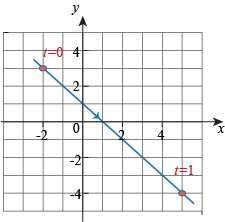

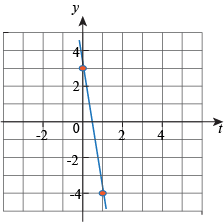
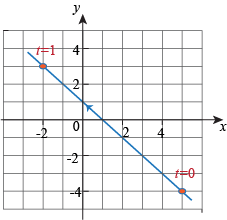
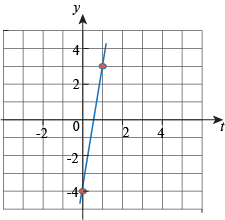
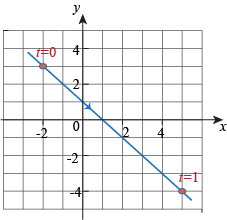
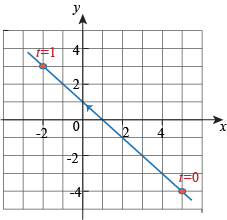


 ,
,



 the equation for x is
x(t) = 40t.
the equation for x is
x(t) = 40t. 
 so
the equation for y is
so
the equation for y is .
.

 .
.
 .
.